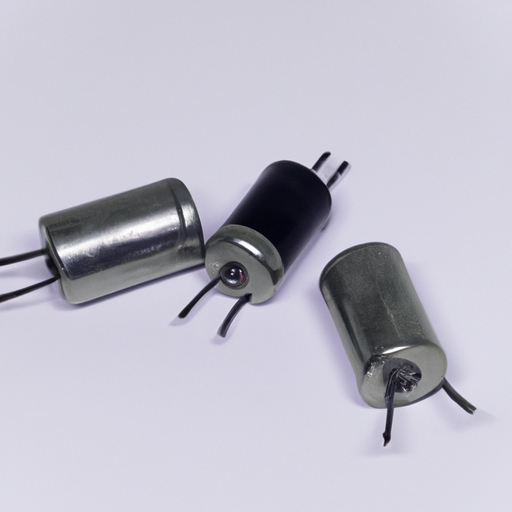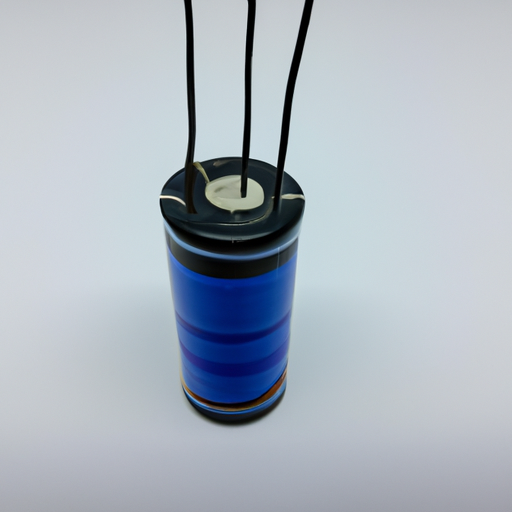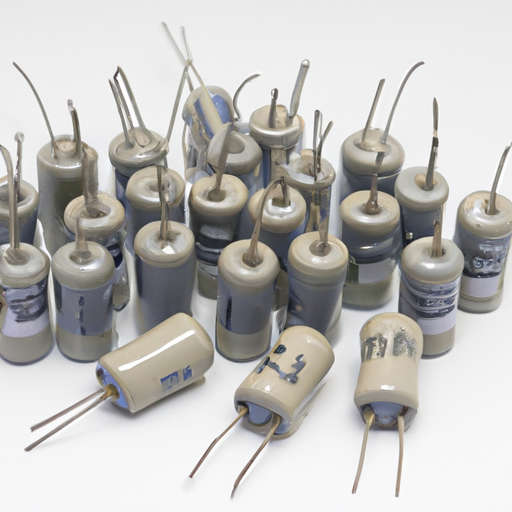What are the product characteristics of automotive capacitors?
What are the Product Characteristics of Automotive Capacitors?
I. Introduction
A. Definition of Automotive Capacitors
Automotive capacitors are essential electronic components used in various automotive applications to store and release electrical energy. They play a crucial role in stabilizing voltage, filtering signals, and providing power to different systems within a vehicle. These capacitors are designed to withstand the harsh conditions of automotive environments, including temperature fluctuations, vibrations, and electrical noise.
B. Importance of Capacitors in Automotive Applications
Capacitors are vital for the reliable operation of modern vehicles, which increasingly rely on electronic systems for functions such as engine control, infotainment, safety features, and more. They help ensure that these systems operate efficiently and effectively, contributing to overall vehicle performance and safety.
C. Overview of the Article
This article will explore the various types of automotive capacitors, their key product characteristics, performance metrics, environmental considerations, and applications within the automotive industry. By understanding these aspects, manufacturers and engineers can make informed decisions when selecting capacitors for automotive designs.
II. Types of Automotive Capacitors
A. Ceramic Capacitors
1. Characteristics
Ceramic capacitors are made from ceramic materials and are known for their small size, high stability, and low cost. They typically have a high capacitance-to-volume ratio and can operate over a wide temperature range.
2. Applications in Automotive
These capacitors are commonly used in applications such as decoupling, filtering, and timing circuits due to their reliability and performance in high-frequency environments.
B. Electrolytic Capacitors
1. Characteristics
Electrolytic capacitors are polarized components that offer high capacitance values in a relatively small package. They are known for their ability to handle large ripple currents but have a limited lifespan compared to other types.
2. Applications in Automotive
These capacitors are often used in power supply circuits, energy storage, and smoothing applications, where high capacitance is required.
C. Film Capacitors
1. Characteristics
Film capacitors are made from thin plastic films and are known for their excellent stability, low ESR, and high insulation resistance. They are non-polarized and can handle high voltages.
2. Applications in Automotive
Film capacitors are used in applications such as audio systems, power electronics, and motor control due to their reliability and performance.
D. Tantalum Capacitors
1. Characteristics
Tantalum capacitors are known for their high capacitance values and small size. They have a stable capacitance over a wide temperature range and are less prone to failure than electrolytic capacitors.
2. Applications in Automotive
These capacitors are often used in critical applications such as power management and signal processing, where reliability is paramount.
III. Key Product Characteristics
A. Voltage Rating
1. Definition and Importance
The voltage rating of a capacitor indicates the maximum voltage it can handle without failing. Exceeding this rating can lead to catastrophic failure, making it a critical specification in automotive applications.
2. Common Voltage Ratings in Automotive Applications
Automotive capacitors typically have voltage ratings ranging from 16V to 100V, depending on the application and system requirements.
B. Capacitance Value
1. Definition and Importance
Capacitance value refers to the amount of electrical charge a capacitor can store. It is measured in farads (F) and is crucial for determining how well a capacitor can perform its intended function.
2. Typical Capacitance Values in Automotive Systems
Capacitance values in automotive applications can range from microfarads (µF) for decoupling capacitors to millifarads (mF) for energy storage applications.
C. Temperature Range
1. Definition and Importance
The temperature range indicates the operating conditions under which a capacitor can function effectively. Automotive capacitors must withstand extreme temperatures due to varying environmental conditions.
2. Operating Temperature Ranges for Automotive Capacitors
Most automotive capacitors are designed to operate within a temperature range of -40°C to +125°C, ensuring reliability in diverse climates.
D. Size and Form Factor
1. Importance of Size in Automotive Design
The size and form factor of capacitors are critical in automotive design, where space is often limited. Smaller capacitors can be more easily integrated into compact electronic systems.
2. Common Form Factors for Automotive Capacitors
Common form factors include surface mount devices (SMD), through-hole, and axial lead types, each suited for different applications and design constraints.
E. ESR (Equivalent Series Resistance)
1. Definition and Importance
ESR is a measure of the resistance a capacitor presents to alternating current (AC). Lower ESR values are desirable as they indicate better performance and efficiency.
2. Impact on Performance in Automotive Applications
High ESR can lead to increased heat generation and reduced efficiency, making it essential to select capacitors with appropriate ESR values for specific automotive applications.
F. Lifespan and Reliability
1. Factors Affecting Lifespan
The lifespan of a capacitor can be influenced by factors such as temperature, voltage stress, and ripple current. Understanding these factors is crucial for ensuring long-term reliability.
2. Reliability Standards in Automotive Capacitors
Automotive capacitors must meet stringent reliability standards, such as AEC-Q200, which outlines testing and qualification requirements for electronic components in automotive applications.
IV. Performance Characteristics
A. Frequency Response
1. Importance in Automotive Electronics
Frequency response refers to how a capacitor behaves at different frequencies. It is crucial for applications involving signal processing and filtering.
2. Typical Frequency Ranges for Automotive Applications
Automotive capacitors are often required to perform effectively across a wide frequency range, from low frequencies in power applications to high frequencies in communication systems.
B. Ripple Current Handling
1. Definition and Importance
Ripple current refers to the AC component of the current flowing through a capacitor. Capacitors must be able to handle ripple currents without overheating or failing.
2. Applications Requiring High Ripple Current Capacitors
High ripple current capacitors are essential in power supply circuits, where they smooth out voltage fluctuations and ensure stable operation.
C. Self-Resonant Frequency
1. Definition and Importance
Self-resonant frequency is the frequency at which a capacitor's reactance becomes zero, causing it to behave like a short circuit. Understanding this frequency is vital for circuit design.
2. Implications for Circuit Design
Designers must consider self-resonant frequency when selecting capacitors to ensure they operate effectively within the intended frequency range of the application.
V. Environmental Considerations
A. RoHS Compliance
1. Definition and Importance
RoHS (Restriction of Hazardous Substances) compliance ensures that electronic components do not contain harmful substances. This is crucial for environmental protection and regulatory compliance.
2. Impact on Manufacturing and Design
Manufacturers must ensure that automotive capacitors meet RoHS standards, which can influence material selection and manufacturing processes.
B. Thermal Management
1. Importance of Heat Dissipation
Effective thermal management is essential for maintaining capacitor performance and longevity, especially in high-power applications where heat generation is significant.
2. Strategies for Effective Thermal Management
Strategies include using heat sinks, thermal pads, and proper circuit layout to enhance heat dissipation and maintain optimal operating temperatures.
C. Vibration and Shock Resistance
1. Importance in Automotive Applications
Automotive environments expose components to significant vibrations and shocks. Capacitors must be designed to withstand these conditions to ensure reliability.
2. Testing Standards and Methods
Testing standards, such as ISO 16750, outline the requirements for vibration and shock resistance in automotive components, ensuring that capacitors can endure real-world conditions.
VI. Applications of Automotive Capacitors
A. Power Supply Systems
Capacitors are used in power supply systems to stabilize voltage and provide energy storage, ensuring reliable operation of electronic components.
B. Signal Processing
In signal processing applications, capacitors filter out noise and stabilize signals, contributing to the overall performance of communication systems.
C. Motor Control
Capacitors play a crucial role in motor control applications, providing the necessary energy for starting and running motors efficiently.
D. Energy Storage Systems
Capacitors are used in energy storage systems to store and release energy quickly, supporting applications such as regenerative braking in electric vehicles.
E. Safety and Control Systems
In safety and control systems, capacitors ensure the reliable operation of critical functions, such as airbag deployment and anti-lock braking systems.
VII. Conclusion
A. Summary of Key Points
Automotive capacitors are essential components that contribute to the performance, reliability, and safety of modern vehicles. Understanding their types, characteristics, and applications is crucial for engineers and manufacturers.
B. Future Trends in Automotive Capacitor Technology
As automotive technology continues to evolve, the demand for more efficient, reliable, and compact capacitors will grow. Innovations in materials and manufacturing processes will likely lead to enhanced performance and new applications.
C. Final Thoughts on the Importance of Capacitors in Automotive Design
Capacitors are integral to the functionality of automotive systems, and their selection should be approached with careful consideration of the specific requirements of each application. By prioritizing quality and performance, manufacturers can ensure the reliability and safety of their vehicles.
VIII. References
A. Academic Journals
- IEEE Transactions on Industrial Electronics
- Journal of Power Sources
B. Industry Reports
- IHS Markit Automotive Electronics Report
- MarketsandMarkets Automotive Capacitors Market Report
C. Manufacturer Specifications
- Manufacturer datasheets for automotive capacitors
- Technical documents from leading capacitor manufacturers
D. Standards Organizations
- International Organization for Standardization (ISO)
- Automotive Electronics Council (AEC)






